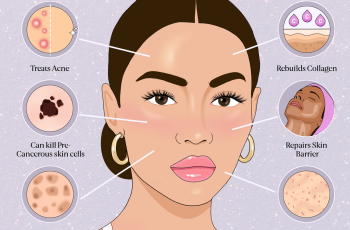
The Science of Skin Inflammation: A Comprehensive Overview
Skin inflammation is a complex, multi-step biological process triggered by a wide array of stimuli ranging from pathogens and allergens to environmental damage and internal imbalances.
It plays a dual role in the human body: on one hand, it is a defense mechanism vital to healing; on the other hand, chronic or dysregulated inflammation can be damaging and contributes to numerous skin disorders.
This comprehensive guide provides a scientific overview of the inflammatory mechanisms that operate within the skin.
It draws from foundational content adapted from Chapter 38 of Baumann’s Cosmetic Dermatology (McGraw Hill, 2022), elaborating on the molecular and cellular players that initiate and propagate inflammation in response to both external insults and internal triggers.
What Is Skin Inflammation?
Inflammation is the body’s protective response to harmful stimuli, such as pathogens, damaged cells, toxic compounds, or physical injury.
It involves immune cells, blood vessels, and molecular mediators. In the skin, inflammation is characterized by redness, swelling, warmth, pain, and often itching or dysfunction of the skin barrier. While acute inflammation is beneficial for healing, chronic inflammation can cause long-term tissue damage, pigmentation issues, premature aging, and disease progression.
Skin inflammation can be initiated through multiple interconnected pathways, each influencing and amplifying the others in a domino-like fashion.
The following sections explore the most important mechanisms involved.
1. Eicosanoids and the Arachidonic Acid Pathway
Arachidonic Acid (AA) Metabolism
One of the earliest molecular signals in skin inflammation arises from the cell membrane, where phospholipase A2 (PLA2) acts on membrane phospholipids to release arachidonic acid (AA).
This omega-6 polyunsaturated fatty acid serves as the precursor to a group of potent signaling molecules known as eicosanoids, which include:
Prostaglandins (PGs)
Thromboxanes (TXs)
Leukotrienes (LTs)
Prostacyclins
These compounds have diverse and powerful biological effects, especially in inflammation and immunity. Two main enzymatic pathways convert AA into these mediators:
Cyclooxygenase (COX) Pathway
This pathway produces prostaglandins, thromboxanes, and prostacyclins. Two main cyclooxygenase enzymes are involved:
COX-1: A constitutive enzyme expressed in most tissues. It maintains homeostatic functions like gastric protection and platelet aggregation.
COX-2: An inducible enzyme that is rapidly upregulated in response to pro-inflammatory stimuli such as cytokines and bacterial endotoxins.
Its products play a central role in inflammation and pain.
COX-derived eicosanoids mediate vasodilation, increased vascular permeability, and pain—all hallmarks of inflammation.
Lipoxygenase (LOX) Pathway
The LOX pathway transforms AA into hydroperoxyeicosatetraenoic acids (HPETEs)—such as 5-HPETE, 12-HPETE, and 15-HPETE—which are further reduced to hydroxyeicosatetraenoic acids (HETEs), leukotrienes, and lipoxins.
Leukotrienes (especially LTB4) are highly chemotactic and attract immune cells to the site of injury.
Lipoxins help resolve inflammation, acting as a counterbalance to leukotrienes.
These lipid mediators are essential players in orchestrating immune responses in the skin.
2. Cytokines: The Molecular Messengers of Inflammation
Cytokines are small signaling proteins secreted by immune and skin cells to communicate with one another.
In inflammatory skin conditions, cytokines are primarily released by immune cells such as macrophages and monocytes, though keratinocytes and fibroblasts can also produce them.
Key Pro-Inflammatory Cytokines
Interleukin-1 (IL-1) and Tumor Necrosis Factor-alpha (TNF-α) are major orchestrators of the inflammatory cascade. They stimulate the release of:
Proteases (which degrade tissue),
Reactive oxygen species (ROS),
Other cytokines and eicosanoids.
Interferon-gamma (IFN-γ) and Granulocyte Colony-Stimulating Factor (G-CSF) enhance the production of IL-1 and TNF-α, amplifying inflammation.
These cytokines are involved in many skin conditions, including acne, psoriasis, eczema, and allergic reactions.
3. Chemokines: The Navigators of Immune Cells
Chemokines are a specialized subset of cytokines with chemotactic properties. They guide immune cells—such as neutrophils, eosinophils, and lymphocytes—to sites of tissue damage or infection.
During skin inflammation, chemokines:
Recruit immune cells from the bloodstream,
Direct them toward the inflamed tissue,
Play a role in both initiating and resolving inflammation.
Persistent overproduction of chemokines can result in chronic inflammatory states and tissue damage.
4. Mast Cells and Histamine in Skin Inflammation
Mast cells are resident immune cells in the skin and other tissues, best known for their role in allergic responses. They contain granules rich in histamine and other inflammatory mediators.
Activation Triggers
Mast cells can be activated through several mechanisms:
IgE binding and crosslinking upon exposure to allergens,
Physical stimuli such as heat, cold, and UV radiation,
Microbial toxins, trauma, and cytokines.
Outcomes of Activation
Upon activation, mast cells undergo degranulation, releasing:
Pre-formed mediators: histamine, tryptase, chymase, and heparin.
Newly synthesized lipid mediators: such as leukotrienes (C4, D4, B4) and prostaglandin D2.
Pro-inflammatory cytokines: including TNF-α, IL-4, IL-5, IL-6, and GM-CSF.
These substances cause itching, vasodilation, increased vascular permeability, and recruitment of other immune cells, culminating in the hallmark symptoms of skin allergies like urticaria (hives).
5. Histamine’s Role in Allergic Skin Reactions
Histamine, stored in mast cells, is a key mediator of allergic inflammation. When it binds to specific histamine receptors (especially H1 and H3 receptors), it can:
Promote the release of additional cytokines,
Attract basophils and eosinophils,
Stimulate fibroblasts to remodel tissue,
Cause the characteristic itching of allergic skin diseases.
Histamine’s action on the H1 receptor is primarily responsible for the itching, redness, and swelling associated with allergic reactions.
6. Free Radicals: The Amplifiers of Skin Damage
During inflammation, white blood cells such as neutrophils and macrophages generate reactive oxygen species (ROS) or free radicals as part of their defense against microbes.
However, excessive production of ROS can damage healthy skin cells.
Consequences of ROS in Skin Inflammation:
Induction of further chemokines and cytokines,
Expression of endothelial adhesion molecules, enhancing immune cell infiltration,
Breakdown of extracellular matrix components like collagen, elastin, and hyaluronic acid,
Acceleration of skin aging and pigmentation changes.
Antioxidants in skincare can help mitigate these effects by neutralizing ROS and restoring redox balance.
7. Kinins and the Kallikrein-Kinin System
Kinins such as bradykinin (BK) and kallidin (KD) are peptide mediators that are rapidly formed after skin injury through activation of the kallikrein-kinin system.
These molecules have a range of effects on skin inflammation:
Increase vascular permeability,
Stimulate the release of arachidonic acid,
Promote eicosanoid synthesis,
Activate NF-κB, a transcription factor that regulates the expression of pro-inflammatory genes.
Kinins are also involved in the sensation of pain and itching, making them crucial targets for anti-inflammatory therapies.
Final Thoughts: Implications for Skin Health and Treatment
The process of skin inflammation is intricate and involves multiple overlapping pathways that can either promote healing or lead to chronic skin conditions if not properly regulated.
Understanding the molecular science behind inflammation offers a roadmap for targeted treatment and prevention.
Modern dermatology increasingly focuses on anti-inflammatory skincare that targets:
COX and LOX pathways (via botanicals or NSAIDs),
Cytokine signaling (via immunomodulators),
Mast cell stabilization (via antihistamines),
Antioxidant protection (via vitamin C, E, niacinamide),
Kinin inhibition (via emerging peptides and topical agents).
With ongoing research, more refined therapies are being developed to manage inflammation without suppressing the skin’s natural defenses.


